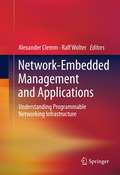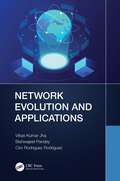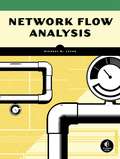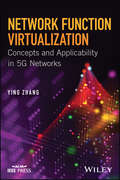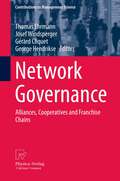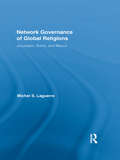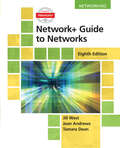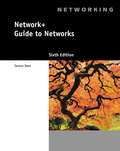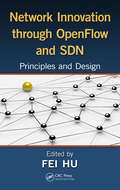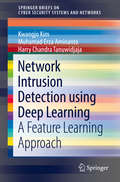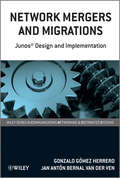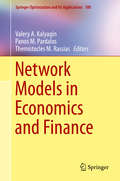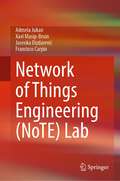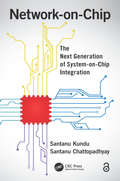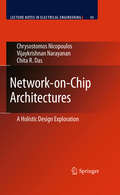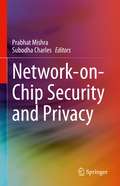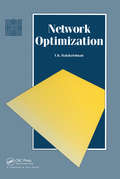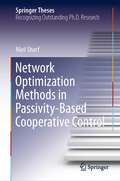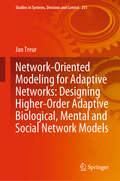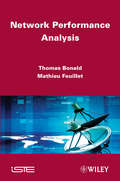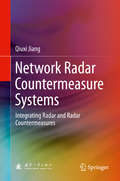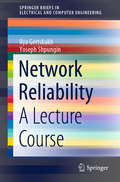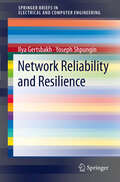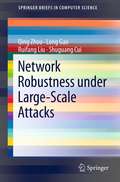- Table View
- List View
Network-Embedded Management and Applications
by Ralf Wolter Alexander ClemmDespite the explosion of networking services and applications in the past decades, the basic technological underpinnings of the Internet have remained largely unchanged. At its heart are special-purpose appliances that connect us to the digital world, commonly known as switches and routers. Now, however, the traditional framework is being increasingly challenged by new methods that are jostling for a position in the "next-generation" Internet. The concept of a network that is becoming more programmable is one of the aspects that are taking center stage. This opens new possibilities to embed software applications inside the network itself and to manage networks and communications services with unprecedented ease and efficiency. In this edited volume, distinguished experts take the reader on a tour of different facets of programmable network infrastructure and applications that exploit it. Presenting the state of the art in network embedded management and applications and programmable network infrastructure, the book conveys fundamental concepts and provides a glimpse into various facets of the latest technology in the field.
Network Evolution and Applications
by Vikas Kumar Jha Bishwajeet Kumar Pandey Ciro RodriguezNetwork Evolution and Applications provides a comprehensive, integrative, and easy approach to understanding the technologies, concepts, and milestones in the history of networking. It provides an overview of different aspects involved in the networking arena that includes the core technologies that are essential for communication and important in our day-to-day life. It throws some light on certain past networking concepts and technologies that have been revolutionary in the history of science and technology and have been highly impactful. It expands on various concepts like Artificial Intelligence, Software Defined Networking, Cloud Computing, and Internet of Things, which are very popular at present. This book focuses on the evolutions made in the world of networking. One can’t imagine the world without the Internet today; with the Internet and the present- day networking, distance doesn’t matter at all. The COVID-19 pandemic has resulted in a tough time worldwide, with global lockdown, locked homes, empty streets, stores without consumers, and offices with no or fewer staff. Thanks to the modern digital networks, the culture of work from home (WFH) or working remotely with the network/Internet connection has come to the fore, with even school and university classes going online. Although WFH is not new, the COVID-19 pandemic has given it a new look, and industries are now willfully exploring WFH to extend it in the future. The aim of this book is to present the timeline of networking to show the developments made and the milestones that were achieved due to these developments.
Network Flow Analysis (No Starch Press Ser.)
by Michael W. LucasYou know that servers have log files and performance measuring tools and that traditional network devices have LEDs that blink when a port does something. You may have tools that tell you how busy an interface is, but mostly a network device is a black box. Network Flow Analysis opens that black box, demonstrating how to use industry-standard software and your existing hardware to assess, analyze, and debug your network.Unlike packet sniffers that require you to reproduce network problems in order to analyze them, flow analysis lets you turn back time as you analyze your network. You'll learn how to use open source software to build a flow-based network awareness system and how to use network analysis and auditing to address problems and improve network reliability. You'll also learn how to use a flow analysis system; collect flow records; view, filter, and report flows; present flow records graphically; and use flow records to proactively improve your network. Network Flow Analysis will show you how to:–Identify network, server, router, and firewall problems before they become critical–Find defective and misconfigured software–Quickly find virus-spewing machines, even if they’re on a different continent–Determine whether your problem stems from the network or a server–Automatically graph the most useful dataAnd much more. Stop asking your users to reproduce problems. Network Flow Analysis gives you the tools and real-world examples you need to effectively analyze your network flow data. Now you can determine what the network problem is long before your customers report it, and you can make that silly phone stop ringing.
Network Function Virtualization: Concepts And Applicability In 5g Networks (Wiley - Ieee Ser.)
by Ying ZhangA horizontal view of newly emerged technologies in the field of network function virtualization (NFV), introducing the open source implementation efforts that bring NFV from design to reality This book explores the newly emerged technique of network function virtualization (NFV) through use cases, architecture, and challenges, as well as standardization and open source implementations. It is the first systematic source of information about cloud technologies' usage in the cellular network, covering the interplay of different technologies, the discussion of different design choices, and its impact on our future cellular network. Network Function Virtualization: Concepts and Applicability in 5G Networks reviews new technologies that enable NFV, such as Software Defined Networks (SDN), network virtualization, and cloud computing. It also provides an in-depth investigation of the most advanced open source initiatives in this area, including OPNFV, Openstack, and Opendaylight. Finally, this book goes beyond literature review and industry survey by describing advanced research topics such as service chaining, VNF orchestrations, and network verification of NFV systems. In addition, this resource: Introduces network function virtualization (NFV) from both industrial and academic perspectives Describes NFV's usage in mobile core networks, which is the essence of 5G implementation Offers readers a deep dive on NFV's enabling techniques such as SDN, virtualization, and cloud computing Network Function Virtualization: Concepts and Applicability in 5G Networks is an ideal book for researchers and university students who want to keep up with the ever-changing world of network function virtualization.
Network Governance
by Gérard Cliquet George Hendrikse Josef Windsperger Thomas EhrmannThe current book on Nework Governance contributes to the literature by offering new perspectives on network goals and performance, inter-organizational learning and trust in alliances, corporate governance issues in cooperatives, governance of cross-border retail networks, contract design and governance innovations in cooperatives and fanchising.
Network Governance of Global Religions: Jerusalem, Rome, and Mecca (Routledge Research in Information Technology and Society)
by Michel S. LaguerreThis study seeks to explain three models of network governance embedded in digital practices that the mainstream monotheistic religions—Judaism, Catholic Christianity, and Islam—have used to lead and manage the worldwide distribution of their local nodes, exploring the connection between network governance and its digital embeddedness and showing how the latter enhances the performance of the former.
Network+ Guide to Networks (Mindtap Course List Series)
by Jill West Jean Andrews Tamara DeanMaster the technical skills and industry knowledge you need to begin an exciting career installing, configuring and troubleshooting computer networks with West/Dean/Andrews' NETWORK+ GUIDE TO NETWORKS, 8th edition. It thoroughly prepares you for success on CompTIA's Network+ N10-007 certification exam with fully mapped coverage of all objectives, including protocols, topologies, hardware, network design, security and troubleshooting. Virtualization-based projects give you experience working with a wide variety of hardware, software, operating systems and device interactions, while "On the Job" stories, Applying Concepts activities, and Hands-On and Capstone Projects let you explore concepts in more depth. MindTap Networking offers additional practice and certification prep. The text's emphasis on real-world problem solving provides the tools for success in any computing environment.
Network+ Guide to Networks 6th Edition
by Tamara DeanThe completely updated NETWORK+ GUIDE TO NETWORKS, 6th Edition gives readers the technical skills and industry know-how required to begin an exciting career installing, configuring, and troubleshooting computer networks. The text also prepares readers for CompTIA's Network+ N10-005 certification exam with fundamentals in protocols, topologies, hardware, and network design. After exploring TCP/IP, Ethernet, wireless transmission, and security concepts, as well as an all-new chapter on virtual networks, readers can increase their knowledge with the practical "On-the Job" stories, Review Questions, Hands-On Projects, and Case Projects
Network Innovation through OpenFlow and SDN: Principles and Design
by Fei HuThis book explains how to use software-defined networking (SDN) technologies powered by the OpenFlow protocol to build networks that are easy to design, less expensive to build and operate, and more agile and customizable. Among the first books to systematically address the design aspects in SDN/OpenFlow, it presents the insights of expert contributors from around the world. Focused on OpenFlow engineering design and basic principles, it includes coverage of system architectures, language and programming issues, switches, multimedia support, and network operating systems.
Network Intrusion Detection using Deep Learning: A Feature Learning Approach (SpringerBriefs on Cyber Security Systems and Networks)
by Kwangjo Kim Muhamad Erza Aminanto Harry Chandra TanuwidjajaThis book presents recent advances in intrusion detection systems (IDSs) using state-of-the-art deep learning methods. It also provides a systematic overview of classical machine learning and the latest developments in deep learning. In particular, it discusses deep learning applications in IDSs in different classes: generative, discriminative, and adversarial networks. Moreover, it compares various deep learning-based IDSs based on benchmarking datasets. The book also proposes two novel feature learning models: deep feature extraction and selection (D-FES) and fully unsupervised IDS. Further challenges and research directions are presented at the end of the book. Offering a comprehensive overview of deep learning-based IDS, the book is a valuable reerence resource for undergraduate and graduate students, as well as researchers and practitioners interested in deep learning and intrusion detection. Further, the comparison of various deep-learning applications helps readers gain a basic understanding of machine learning, and inspires applications in IDS and other related areas in cybersecurity.
Network Know-How: An Essential Guide for the Accidental Admin
by John RossAre the machines in your office living isolated lives? Do you have a few computers at home that you want to connect to each other and the Internet? The best way to share files on a group of computers is to create a network. But how do you do that?Network Know-How is your guide to connecting your machines, filled with practical advice that will show you how to get things done. You'll learn the nitty-gritty of network setup, design, and maintenance, from running cables and placing wireless access points to configuring file sharing and printing. This practical and comprehensive guide will teach you how to implement security, create intranets, and more. You'll learn how to:–Connect Windows, Macintosh, and Linux computers–Implement network addressing–Configure your network adapters, hubs, switches, and router–Share music, photos, and documents–Automate household appliances and stream digital audio and video to your home entertainment center–Troubleshoot network slowdowns and failuresNo matter which operating system you use, and even if you’ve never installed or run a network before, you’ll get what you need to know in Network Know-How.
Network Mergers and Migrations
by Jan Ant?n Bernal van der Ven Gonzalo G?mez HerreroThis book provides you with guidelines to plan, design, roll out, and accomplish network migration activities with a variety of internetworking case studies. It considers both enterprise and service provider scenarios based on the expertise from Juniper Networks engineers. From Metro Ethernet migration approaches to comprehensive network protocol consolidation and integration, each case study covers JUNOS resources to ensure successful completion at each migration phase. In addition to an appendix of automation scripts and examples and guidelines for each step, the book also describes the modern challenges that evolve in IT networks.
Network Models in Economics and Finance
by Valery A. Kalyagin Panos M. Pardalos Themistocles M. RassiasUsing network models to investigate the interconnectivity in modern economic systems allows researchers to better understand and explain some economic phenomena. This volume presents contributions by known experts and active researchers in economic and financial network modeling. Readers are provided with an understanding of the latest advances in network analysis as applied to economics, finance, corporate governance, and investments. Moreover, recent advances in market network analysis that focus on influential techniques for market graph analysis are also examined. Young researchers will find this volume particularly useful in facilitating their introduction to this new and fascinating field. Professionals in economics, financial management, various technologies, and network analysis, will find the network models presented in this book beneficial in analyzing the interconnectivity in modern economic systems.
Network of Things Engineering (NoTE) Lab
by Admela Jukan Xavi Masip-Bruin Jasenka Dizdarević Francisco CarpioThis book provides a hands-on experience in software and hardware engineering of IoT devices in edge and cloud computing systems, by putting in practice state-of-the-art concepts of hardware devices, networking and computing software. It proposes a Network of Things Engineering (NoTE) Lab, with seven hands-on lab modules covering topics ranging from “Interfacing sensors and actuators” and “Connecting IoT and Edge with MQTT" to “Data pipelining in cloud computing”. All tools and software used in the NoTE Lab are free and open source, and available to the readers. Specifically, Arduino-based boards that support a variety of low-cost sensors and actuators are used in IoT context. In edge computing, NoTE Lab implements off-the-shelf single board computers, Raspberry Pis with corresponding software and hardware. For cloud, well-known and widely used cloud computing open-source tools (e.g., Kubernetes) are deployed, where readers can learn the basics of monitoring and managing containers in cloud computing. Three communication protocols are used in the end-to-end setup, including MQTT, AMQP and HTTP. This lab book is a "must experiment with" for anybody in academia and industry participating in the fascinating IoT-edge-cloud continuum development.
Network-on-Chip: The Next Generation of System-on-Chip Integration
by Santanu Kundu Santanu ChattopadhyayAddresses the Challenges Associated with System-on-Chip Integration Network-on-Chip: The Next Generation of System-on-Chip Integration examines the current issues restricting chip-on-chip communication efficiency, and explores Network-on-chip (NoC), a promising alternative that equips designers with the capability to produce a scalable, reusable, and high-performance communication backbone by allowing for the integration of a large number of cores on a single system-on-chip (SoC). This book provides a basic overview of topics associated with NoC-based design: communication infrastructure design, communication methodology, evaluation framework, and mapping of applications onto NoC. It details the design and evaluation of different proposed NoC structures, low-power techniques, signal integrity and reliability issues, application mapping, testing, and future trends. Utilizing examples of chips that have been implemented in industry and academia, this text presents the full architectural design of components verified through implementation in industrial CAD tools. It describes NoC research and developments, incorporates theoretical proofs strengthening the analysis procedures, and includes algorithms used in NoC design and synthesis. In addition, it considers other upcoming NoC issues, such as low-power NoC design, signal integrity issues, NoC testing, reconfiguration, synthesis, and 3-D NoC design. This text comprises 12 chapters and covers: The evolution of NoC from SoC—its research and developmental challenges NoC protocols, elaborating flow control, available network topologies, routing mechanisms, fault tolerance, quality-of-service support, and the design of network interfaces The router design strategies followed in NoCs The evaluation mechanism of NoC architectures The application mapping strategies followed in NoCs Low-power design techniques specifically followed in NoCs The signal integrity and reliability issues of NoC The details of NoC testing strategies reported so far The problem of synthesizing application-specific NoCs Reconfigurable NoC design issues Direction of future research and development in the field of NoC Network-on-Chip: The Next Generation of System-on-Chip Integration covers the basic topics, technology, and future trends relevant to NoC-based design, and can be used by engineers, students, and researchers and other industry professionals interested in computer architecture, embedded systems, and parallel/distributed systems.
Network-on-Chip Architectures
by Chita R. Das Vijaykrishnan Narayanan Chrysostomos NicopoulosThe continuing reduction of feature sizes into the nanoscale regime has led to dramatic increases in transistor densities. Integration at these levels has highlighted the criticality of the on-chip interconnects. Network-on-Chip (NoC) architectures are viewed as a possible solution to burgeoning global wiring delays in many-core chips, and have recently crystallized into a significant research domain. On-chip networks instill a new flavor to communication research due to their inherently resource-constrained nature. Despite the lightweight character demanded of the NoC components, modern designs require ultra-low communication latencies in order to cope with inflating data bandwidths. The work presented in Network-on-Chip Architectures addresses these issues through a comprehensive exploration of the design space. The design aspects of the NoC are viewed through a penta-faceted prism encompassing five major issues: (1) performance, (2) silicon area consumption, (3) power/energy efficiency, (4) reliability, and (5) variability. These five aspects serve as the fundamental design drivers and critical evaluation metrics in the quest for efficient NoC implementations. The research exploration employs a two-pronged approach: (a) MICRO-architectural innovations within the major NoC components, and (b) MACRO-architectural choices aiming to seamlessly merge the interconnection backbone with the remaining system modules. These two research threads and the aforementioned five key metrics mount a holistic and in-depth attack on most issues surrounding the design of NoCs in multi-core architectures.
Network-on-Chip Security and Privacy
by Prabhat Mishra Subodha CharlesThis book provides comprehensive coverage of Network-on-Chip (NoC) security vulnerabilities and state-of-the-art countermeasures, with contributions from System-on-Chip (SoC) designers, academic researchers and hardware security experts. Readers will gain a clear understanding of the existing security solutions for on-chip communication architectures and how they can be utilized effectively to design secure and trustworthy systems.
Network Optimization
by V. BalakrishnanProblems in network optimization arise in all areas of technology and industrial management. The topic of network flows has applications in diverse fields such as chemistry, engineering, management science, scheduling and transportation, to name a few. Network Optimization introduces the subject to undergraduate and graduate students in computer science, mathematics and operations research. The focus is mainly on developing the mathematical underpinnings of the techniques that make it possible to solve the several optimization problems covered in the text. The text discusses such topics as optimal branching problems, transshipment problems, shortest path problems, minimum cost flow problems, maximum flow problems, matching in bipartite and nonbipartite graphs and many applications to combinatorics. Also included is a large number of exercises.
Network Optimization Methods in Passivity-Based Cooperative Control (Springer Theses)
by Miel SharfThis book establishes an important mathematical connection between cooperative control problems and network optimization problems. It shows that many cooperative control problems can in fact be understood, under certain passivity assumptions, using a pair of static network optimization problems. Merging notions from passivity theory and network optimization, it describes a novel network optimization approach that can be applied to the synthesis of controllers for diffusively-coupled networks of passive (or passivity-short) dynamical systems. It also introduces a data-based, model-free approach for the synthesis of network controllers for multi-agent systems with passivity-short agents. Further, the book describes a method for monitoring link faults in multi-agent systems using passivity theory and graph connectivity. It reports on some practical case studies describing the effectivity of the developed approaches in vehicle networks. All in all, this book offers an extensive source of information and novel methods in the emerging field of multi-agent cooperative control, paving the way to future developments of autonomous systems for various application domains
Network-Oriented Modeling for Adaptive Networks: Designing Higher-Order Adaptive Biological, Mental and Social Network Models (Studies in Systems, Decision and Control #251)
by Jan TreurThis book addresses the challenging topic of modeling adaptive networks, which often manifest inherently complex behavior. Networks by themselves can usually be modeled using a neat, declarative, and conceptually transparent Network-Oriented Modeling approach. In contrast, adaptive networks are networks that change their structure; for example, connections in Mental Networks usually change due to learning, while connections in Social Networks change due to various social dynamics. For adaptive networks, separate procedural specifications are often added for the adaptation process. Accordingly, modelers have to deal with a less transparent, hybrid specification, part of which is often more at a programming level than at a modeling level. This book presents an overall Network-Oriented Modeling approach that makes designing adaptive network models much easier, because the adaptation process, too, is modeled in a neat, declarative, and conceptually transparent Network-Oriented Modeling manner, like the network itself. Thanks to this approach, no procedural, algorithmic, or programming skills are needed to design complex adaptive network models. A dedicated software environment is available to run these adaptive network models from their high-level specifications. Moreover, because adaptive networks are described in a network format as well, the approach can simply be applied iteratively, so that higher-order adaptive networks in which network adaptation itself is adaptive (second-order adaptation), too can be modeled just as easily. For example, this can be applied to model metaplasticity in cognitive neuroscience, or second-order adaptation in biological and social contexts. The book illustrates the usefulness of this approach via numerous examples of complex (higher-order) adaptive network models for a wide variety of biological, mental, and social processes. The book is suitable for multidisciplinary Master’s and Ph.D. students without assuming much prior knowledge, although also some elementary mathematical analysis is involved. Given the detailed information provided, it can be used as an introduction to Network-Oriented Modeling for adaptive networks. The material is ideally suited for teaching undergraduate and graduate students with multidisciplinary backgrounds or interests. Lecturers will find additional material such as slides, assignments, and software.
Network Performance Analysis (Wiley-iste Ser.)
by Thomas Bonald Mathieu FeuilletThe book presents some key mathematical tools for the performance analysis of communication networks and computer systems. Communication networks and computer systems have become extremely complex. The statistical resource sharing induced by the random behavior of users and the underlying protocols and algorithms may affect Quality of Service. This book introduces the main results of queuing theory that are useful for analyzing the performance of these systems. These mathematical tools are key to the development of robust dimensioning rules and engineering methods. A number of examples illustrate their practical interest.
Network Radar Countermeasure Systems
by Qiuxi JiangThis is the very first book to present the network radar countermeasure system. It explains in detail the systematic concept of combining radar and radar countermeasures from the perspective of the information acquisition of target location, the optimization of the reconnaissance and detection, the integrated attack of the signals and facilities, and technological and legal developments concerning the networked system. It achieves the integration of the initiative and passivity, detection and jamming. The book explains how the system locates targets, completes target identification, tracks targets and compiles the data.
Network Reliability: A Lecture Course (SpringerBriefs in Electrical and Computer Engineering)
by Ilya Gertsbakh Yoseph ShpunginThis introductory book equips the reader to apply the core concepts and methods of network reliability analysis to real-life problems. It explains the modeling and critical analysis of systems and probabilistic networks, and requires only a minimal background in probability theory and computer programming. Based on the lecture notes of eight courses taught by the authors, the book is also self-contained, with no theory needed beyond the lectures. The primary focus is on essential “modus operandi,” which are illustrated in numerous examples and presented separately from the more difficult theoretical material.
Network Reliability and Resilience
by Ilya Gertsbakh Yoseph ShpunginThis book is devoted to the probabilistic description of the behavior of a network in the process of random removal of its components (links, nodes) appearing as a result of technical failures, natural disasters or intentional attacks. It is focused on a practical approach to network reliability and resilience evaluation, based on applications of Monte Carlo methodology to numerical approximation of network combinatorial invariants, including so-called multidimensional destruction spectra. This allows to develop a probabilistic follow-up analysis of the network in the process of its gradual destruction, to identify most important network components and to develop efficient heuristic algorithms for network optimal design. Our methodology works with satisfactory accuracy and efficiency for most applications of reliability theory to real -life problems in networks.
Network Robustness under Large-Scale Attacks
by Ruifang Liu Shuguang Cui Qing Zhou Long GaoNetwork Robustness under Large-Scale Attacks provides the analysis of network robustness under attacks, with a focus on large-scale correlated physical attacks. The book begins with a thorough overview of the latest research and techniques to analyze the network responses to different types of attacks over various network topologies and connection models. It then introduces a new large-scale physical attack model coined as area attack, under which a new network robustness measure is introduced and applied to study the network responses. With this book, readers will learn the necessary tools to evaluate how a complex network responds to random and possibly correlated attacks.
